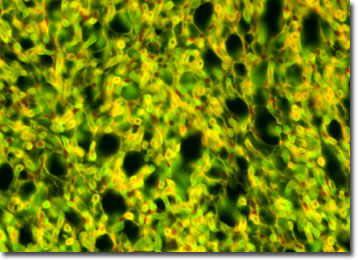Fluorescence Digital Image Gallery
Bird Lung
At rest, a bird's oxygen consumption rate is higher than all other vertebrates. That rate is even higher when engaging in activities such as flying. Birds are capable of high rates of gas exchange because of the special construction of their lungs, and additional breathing organs, a complex series of air sacs.

Connecting tubes join the lungs to these air sacs, increasing a bird's respiratory capacity to about twice that of any mammal of comparable size. The lungs don't inflate and deflate like balloons, as they do in mammals, but are kept inflated by the air sacs, which pump a continuous flow of fresh air through the lungs. This system is far more efficient than that of any living mammal. While climbing Mt. Everest, mountaineers are likely to see Himalayan geese soaring upward, honking all the while to express their superior lung power over humans.
Birds, warm-blooded vertebrates of the class Aves, are unique for their feathers. Feathers and other specialized body structures make birds the best fliers of the animal kingdom. However, some species, such as penguins, ostriches and kiwis are flightless. While most migratory birds use flying as a means of transportation, flightless birds walk, swim, or even float. California quail walk up and down mountains to reach their seasonal homes. Greenland's murres swim and Adelie penguins have been known to hitch a ride on passing ice floes.
Over 8,700 species of birds are in existence today and scientists have discovered fossils from over 1,000 species of extinct birds. Costa Rica has the richest diversity of birds with over 700 species. The smallest living bird is the bee hummingbird of Cuba, only 2.5 inches long. The largest bird is the ostrich, which can reach a towering eight feet tall.
The specimen presented here was imaged with a Nikon Eclipse E600 microscope operating with fluorite and/or apochromatic objectives and vertical illuminator equipped with a mercury arc lamp. Specimens were illuminated through Nikon dichromatic filter blocks containing interference filters and a dichroic mirror and imaged with standard epi-fluorescence techniques. Specific filters for the bird lung stained thin section were a B-2E/C and a Y-2E/C. Photomicrographs were captured with an Optronics MagnaFire digital camera system coupled to the microscope with a lens-free C-mount adapter.
BACK TO THE FLUORESCENCE DIGITAL IMAGE GALLERY
